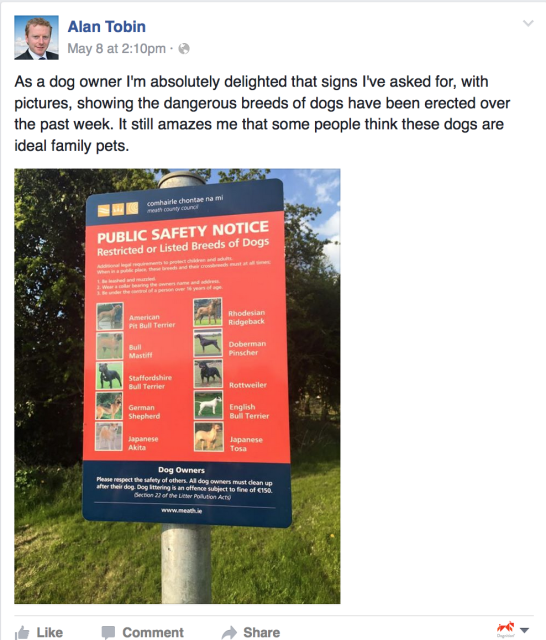By Brian Hare and Vanessa Woods
On Facebook, Irish politician Alan Tobin posted a picture of a ‘dangerous dog breed’ signs that required owners of those breeds to be ‘leashed and muzzled’.
There is absolutely no science to support that one breed is more dangerous than another. Or rather, there is so much noise in the data, that the results are inconclusive. For example, one analysis of 84 dog bites in children found pitbulls were responsible for ‘a notable proportion’ of bites, but this was only 13%. Another found that the top biting culprit was German shepherds, and another was English springer spaniels. In a review of studies from 1971 – 1989 , here is a sample of dogs that were found to be among the ‘top three’ biters: chow chows, collies, German shepherds, mixed breeds, American Staffordshire terriers, cocker spaniels, Saint Bernards, Lhasa apsos, Doberman pinschers, Rottweilers, poodles, and duck tolling retrievers. The data is all over the place.
Also, when a hospital records that the dog who bit a child was a certain breed, they rely on the report of the victim, parents, or a witness. No one does a DNA test to make sure. For instance, any dog with short hair, medium build and a broad face might be called a pitbull. And Scott and Fuller found that sometimes dogs end up looking nothing like either parent. When they crossed basenjis and cocker spaniels, most of the puppies were unidentifiable except they were about medium build with splotchy coats. This means that looks can be deceiving. A dog that looks nothing like a pitbull may have pitbull genes, while a dog that looks like a pitbull is nothing of the sort.
Imposing a ban on a breed of dog creates a false sense of security and persecutes a breed that is probably not even responsible for most of the injuries.
While we are not sure about breed differences when it comes to aggression, what science can tell us is that 70% of bites happen to children under the age of 10. Over 60% of the children bitten are boys, and 87% are white. Children are most frequently bitten (61% of the time) when they come in contact with the dog’s food or possessions. The children will usually be injured in the head and neck area, 55% to the cheek and lips with the average length of the wound being three inches. Most breeds are large dogs and male dogs are more likely to bite than female dogs. Two thirds of the dogs who bite children have never before bitten a child and between 25% – 33% of the dogs who bit were the family dog.
So in conclusion, the breed most likely to be involved in a serious dog related injury is a child, usually a white male under the age of 10, with a large male dog living in the family home.
This post was adapted from the New York Times Bestseller ‘The Genius of Dogs’
Further reading:
Monroy, A., et al., Head and neck dog bites in children. Otolaryngology–Head and Neck Surgery, 2009. 140(3): p. 354.
Brogan, T.V., et al., Severe dog bites in children. Pediatrics, 1995. 96(5): p. 947.
Reisner, I.R., F.S. Shofer, and M.L. Nance, Behavioral assessment of child-directed canine aggression. Injury Prevention, 2007. 13(5): p. 348.
Overall, K.L. and M. Love, Dog bites to humans–demography, epidemiology, injury, and risk. Journal of the American Veterinary Medical Association, 2001. 218(12): p. 1923


